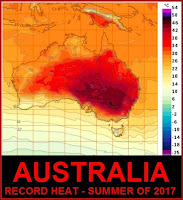Heat records fell like flies last year and this was certainly true in the Arctic. We know that the buildup of greenhouse gasses like carbon dioxide (CO2) cause global warming. In May 2016, the Mauna Loa Observatory recorded 407.7 parts per million of CO2 in the atmosphere, the highest levels of atmospheric carbon ever recorded.
At the end of last year in Australia, there was record heat and drought. The heat continued into the new year with January breaking temperature records in Sydney and Brisbane. In January Sydney broke more records than any month since record taking began in 1858. The hot weather is continuing into the middle of February with some of the hottest temperatures of the summer in Sydney and Melbourne. Even Queensland saw temperatures exceeding 40 degree Celsius. The extreme heat has also contributed to 48 forest fires in New South Wales. Previous research has shown that bush fires are related to climate change.
Inside Climate News reports that heat waves have become more frequent in Australia. This is the view of Sarah Perkins-Kirkpatrick of Australia's Climate Change Research Center at the University of New South Wales:
"In Canberra, Australia's capital, the number of heat wave days has doubled in the past 60 years. In that same time, the beginning of the heatwave season in Sydney has advanced by three weeks, and in Melbourne, heatwaves are hotter," Perkins-Kirkpatrick said. "What's really interesting about this event is that all the physical mechanisms that drive heat waves are not in place."What makes the Australian heat even more remarkable is that it is taking place in the absence of the kind of El Niño and hemispheric wind patterns that normally drive warmer weather. Scientists agree that climate change has a salient role to play. Forest and fire ecologist David Bowman said anthropogenic global warming is making the Earth and Australia hotter.
"In the last few years it has crossed a line—the anomalous weather has become consistently anomalous. I am confident we are seeing climate change play out in bush fires," Bowman said. "We have frittered away precious time debating abstractions or missing the point entirely. Numerous extreme events, seem unfortunately, the only things to spur broader social change."Australia is far from the only place hit by extreme heat. In parts of South America, records are also being broken and massive wildfires have consumed hundreds of thousands of acres.
As reported by the Guardian, Bureau of Meteorology climatologist Agata Imielska said that climate change is driving up temperatures.
“One factor is the ongoing warming trend – we’ve warmed by a degree in the past century and it’s not just about averages, we see increases in these extreme temperatures as well,” Imielska said. “It doesn’t just go for land temperatures, it also goes for ocean temperatures. In 2016 we saw the warmest ocean temperatures on record.”The Australian Bureau of Meteorology said the heat will continue right through into March. Going forward the situation will only get worse. As greenhouse gasses continue to build up in the atmosphere the hot temperatures will increase.
Related
The Warming Temperature Trend Continues Despite Trump
Decades of Hot Data: The Harbingers of an Impending Climate Catastrophe
Rising CO2 Emissions and Ongoing Heat Records Especially in the Arctic
GHGs are Warming the Planet and Contributing to Disasters
Record Breaking Heat Suggests Accelerated Warming
In Australia Climate Policy is a Political Football
The Death of the Great Barrier Reef
Australia Can Dump Coal and Adopt Renewables
Beijing's Coal Plant Closures and Australia's Dirty Energy Projects
Australian Coal Development Projects to Move Forward Despite Concerns
Australia's Stranded Coal Assets
New Report on Extreme Weather in Australia

0 comments:
Post a Comment